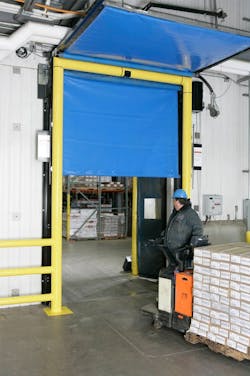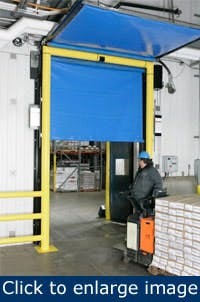Given that high-speed doors improve productivity and save energy, it’s no wonder they’re an increasingly popular choice in almost every fast-moving industrial environment. Yet choosing doors that operate safely at high speeds can be a challenge, considering the advanced technologies involved and diverse options available.
[pullquote]But there’s no need to get hung up in the technicalities. It’s about knowing the basics and what to look for in interior and exterior high-speed doors. Here are 10 tips to guide your decision-making process:
1. Study the application
Almost every industrial door application is unique in some way, which is why it’s important to study the door opening and the door function. Some of the things to consider include the amount of vehicle traffic, the type of lift truck loads involved, typical forklift speeds, traffic patterns and whether pedestrians and lift trucks will share the opening. When it comes to safety, the homework is well worth it.
2. Don’t be lulled into a false sense of security
Warning signals, such as audible alarms and flashing lights, can warn pedestrians and forklift operators that a door is about to move. But the lights and alarms also can become part of the background noise or be viewed as a nuisance if employees are continually exposed to the alerts. Consider carefully the appropriateness of these devices in each specific environment.
3. Gain maximum visibility
Figure 1. A transparent door panel is a boon to safety, but long-term visibility depends on preventing surface scratches on the panel.
More transparency is generally better with any high-speed door (Figure 1). But, also realize that the panels can be scratched or scuffed over time, which can impair visibility. Look for fabric door configurations designed to extend the life of vision panels. In situations where vision panels don’t always work, such as cold storage environment, consider sensor and light communication packages that alert forklift drivers to people and objects moving on the opposite side of the door.
4. Understand reversing mechanisms
These devices help prevent a person from getting trapped under a door held down by its own weight or the force of the door’s drive system. The devices address entrapment in a number of ways, but the basic idea is for the door to sense the obstruction during its travel and return to the open position. The best advice is to use caution when evaluating these features, because reversing mechanisms operate only after an impact has already occurred, and periodic inspection and maintenance is necessary to ensure proper operation.
5. Think flexible bottom edge
Why not avoid the potential for entrapment all together? It’s a question that many plants have answered by choosing doors having a flexible bottom edge. A pliable edge eliminates many of the risks associated with a door that has a heavy, solid-bottom bar. And reversing edge mechanisms aren’t needed to prevent entrapment.
6. Avoid door impacts
Figure 2. Appropriate sensors can help ensure that doors never suffer inadvertent impact with people and machinery.
Minimize the potential for accidents by means of non-contact sensors (Figure 2). These devices determine if an object is in the path of a door, or will soon be in the path of the unit, as it travels. If so, the sensors quickly reverse the door to avoid contact. Non-contact sensors go a long way toward ensuring door safety, which is why a standard safety package typically includes at least one photo eye. But never assume anything. Know what’s standard, the type of sensors available, their mounting location and which sensors are best for the application involved.
7. Take it to the next level
An area-detection system is a good choice if you need an extra level of protection. Unlike non-contact sensors, area-detection systems look outside the plane of the doorway for people and objects approaching the door. If a person or object is detected, the sensor puts the door in a safe condition and prevents it from closing. Before choosing this option, however, consider cross-traffic near the door opening because it can trigger the device and unnecessarily hold the door open. Also, note that these options can be costly and typically must be selected as optional equipment.
8. Train people on door safety
Education is key when safety is the goal. Be sure anyone who will be using the door understands how it operates. And take advantage of door-training seminars the manufacturer or local door representative might offer.
9. Inspect and maintain the door
A door appropriately chosen and properly installed still needs periodic inspection and maintenance. Check the owner’s manual to see what preventive maintenance must be done, then see that someone does it, on schedule, without exception.
10. Select the total package
The best advice is to rely on a knowledgeable and reputable supplier that not only offers the latest technology in high-speed doors, but the ancillary services that contribute to the door’s overall safety. This includes professional installation and after-sale support. Entrust the job to a company with local representation that stands behind its work.
Jim Boerger, P.E., is director of technology and innovation at Rite-Hite Doors, Inc., Milwaukee, Wis. Contact him at [email protected] and (414) 747-7952.


